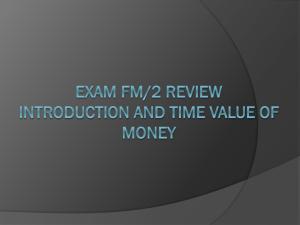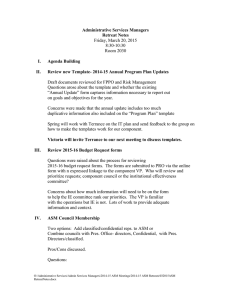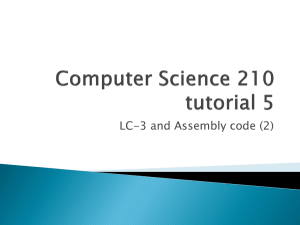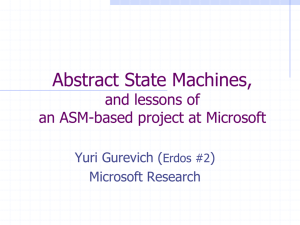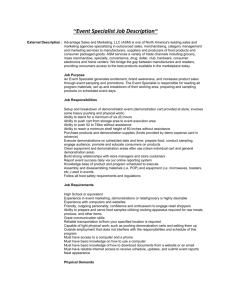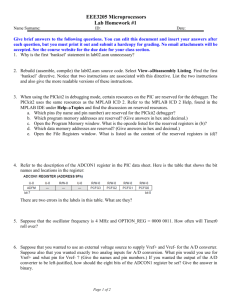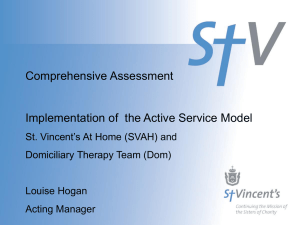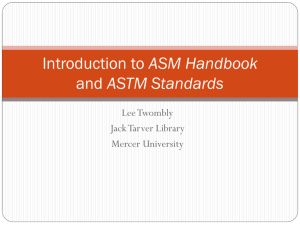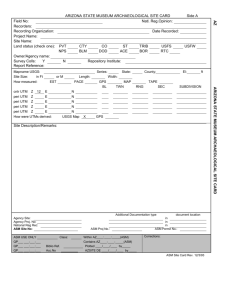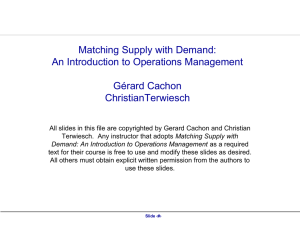Intro and Time Value of Money
advertisement
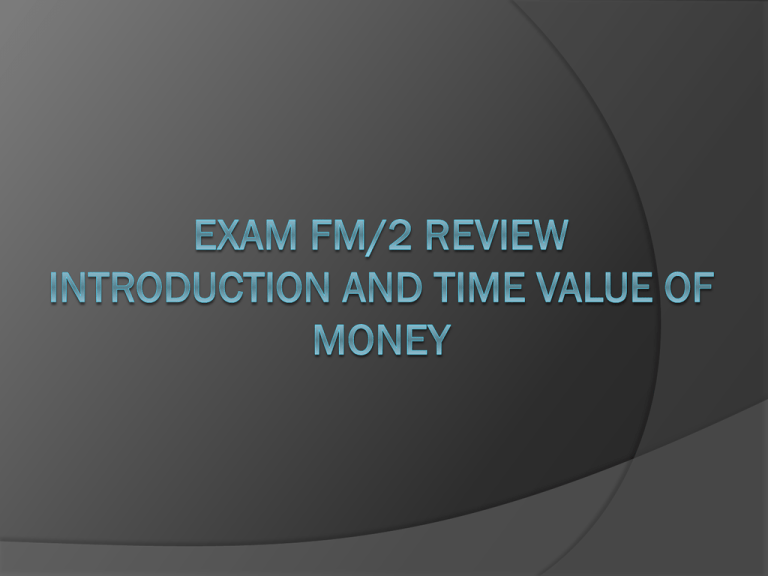
Why Pass Exams? Much more important to employers than GPA (within reason) Big advantage for internships Nearly required for full-time work Best thing you can do right now for your career Immediately: get that internship/full-time job! Later: get on your way to bigger opportunities http://www.actuaryjobs.com/salary.html Easier to pass them now in school than working full-time Exam FM/2 3 hours 35 multiple choice questions Computer-based Preliminary pass/fail Few pilot questions 100 hours of study per exam hour = 300 hours No substitute for time! Schedule February 11th: Cram Session for February FM February 18th: Intro to Time Value of Money February 25th: Annuities March 4th: Loans, Bonds, and Applications March 11th: Spring Break March 18th: Cash Flows, Investments, Duration, and Immunization March 25th: Derivatives and Options, Combinations of Strategies and Hedging April 1st: Forwards, Futures, Swaps and Applications April 10th: Open Review Study Session Format Read ASM/Actex manual and work problems ahead of time Cover concepts and techniques in manual Work problems Answer any final questions How to Get Your Time’s Worth Use these sessions to review and clarify, not to learn Learn from RM 410 and your manual Work problems from the end of ASM before the session Whenever you get a problem wrong, read the solution and do it again until you know it Bring questions General concepts Specific problems How to Prepare You need ~100-200 hours 2 hours/week in this room isn’t enough Supplement your independent study of ASM with the review session and 410 Clarify the details with review sessions Problems, problems, problems Practice tests – practice until you can consistently pass any sample exam Simple Interest Fixed rate per time, actually decreases relative to value 𝑎 𝑡 − 𝑎(𝑡 − 1) 𝑖𝑡 = 𝑎(𝑡 − 1) 𝑎 𝑡 =1+𝑖∗𝑡 Compound Interest Interest on interest 𝑎 𝑡 − 𝑎(𝑡 − 1) 𝑖𝑡 = 𝑎(𝑡 − 1) 𝑎 𝑡 = (1 + 𝑖)𝑡 Present and Future Value PV=Value brought back in time to the present Inverse of accumulation 1 𝑣= (1 + 𝑖)𝑡 FV= Value accumulated into the future Present and Future Value Problems Make sure to always use the same point in time. Pick a point that makes sense and bring every transaction to that point. When in doubt, make a timeline. May need to use calculator to solve (i) Discounting Basically a different way of looking at compound interest, same effect It may help to recognize the formulas, but you can derive them all quickly 𝑎 𝑡 − 𝑎(𝑡 − 1) 𝑑𝑡 = 𝑎(𝑡) 𝐴𝑉 = (1 − 𝑑)−𝑡 𝑃𝑉 = (1 − 𝑑)𝑡 (1 + 𝑖)𝑡 = (1 − 𝑑)−𝑡 M-thly compounding Interest is compounded more frequently, so you make slightly more of it (1 + 𝑖 𝑚 𝑚 )𝑚 = (1 + 𝑖) 𝑑𝑚 𝑚 (1 − ) = (1 − 𝑑) 𝑚 Force of Interest Rate of change with respect to amount 1 𝑑 𝛿𝑡 = 𝑎(𝑡) 𝑎 𝑡 𝑑𝑡 𝑎 𝑡 =𝑒 𝑡2 𝛿 𝑑𝑟 𝑡1 𝑟 If constant rate 𝑎 𝑡 = 𝑒 𝛿 𝑟 ∗𝑡 = 1 + 𝑖 𝑡 Overall problems Make sure to use negative exponent Make sure to always use the same point in time. Pick a point that makes sense and bring every transaction to that point. When in doubt, make a timeline. May need to use calculator to solve (i) Problem 1 An investor puts 100 into Fund X and 100 into Fund Y. Fund Y earns compound interest at the annual rate of j > 0, and Fund X earns simple interest at the annual rate of 1.05j. At the end of 2 years, the amount in Fund Y is equal to the amount in Fund X. Calculate the amount in Fund Y at the end of 5 years. ASM p.22, #6 Answer: 161 Problem 2 Money accumulates in a fund at an effective annual interest rate of i during the first 5 years, and at an effective annual interest rate of 2i thereafter. A deposit of 1 is made into the fund at time 0. It accumulates to 3.09 at the and of 10 years and to 13.62 at the end of 20 years. What is the value of the deposit at the end of 7 years? ASM p.22, #2 Answer: 1.98 Problem 3 Eric deposits X into a savings accout at time 0, which pays interest at a nominal rate of i, compounded semiannually. Mike deposits 2x into a different savings account at time 0, which pays simple interest at an annual rate of i. Eric and Mike earn the same amount of interest during the last 6 months of the 8th year. Calculate i. ASM p.38, #1 Answer: 9.46% Problem 4 Jennifer deposits 1000 into a bank account. The bank credits interest at a nominal annual rate of i convertible semiannually for the first 7 years and a nominal annual rate of 2i convertible quarterly for all years thereafter. The accumulated amount in the account at the end of 5 years is X. The accumulated amount in the account at the end of 10.5 years is 1980. Calculate X. Pg. 38, #6 Answer: 1276 Problem 5 Bruce deposits 100 into a bank account. His account is credited interest at a nominal rate of interest i convertible semiannually. At the same time, Peter deposits 100 into a separate account. Peter’s account is credited interest at a force of interest of δ. After 7.25 years, the value of each account is 200. Calculate (i- δ). ASM p.55, #1 Answer: .23% Problem 6 The force of interest is δt = 0.02t, where t is the number of years from January 1, 2001. If $1.00 is invested on January 1, 2003, how much is in the fund on January 1, 2008. ASM p.67, #1 Answer: 1.568 Problem 7 A fund starts with a zero balance at time zero. The fund accumulates with a varying force of interest A deposit is made at time 2. Calculate the number of years from the time of deposit for the fund to double. ASM p.72, #11 Answer: 1
